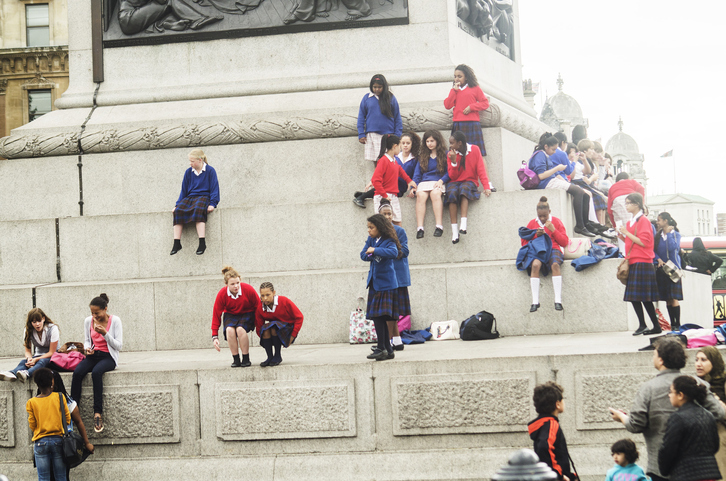BLOG
Health and safety on school trips
Written on 17 June 2022

Out-of-school activities are important both educationally and in terms of wider personal development. They add to the curriculum, build confidence and increase skills.
However, with the threat of HSE scrutiny should accidents occur, and the need to evidence that health and safety hazards were identified and risk properly managed, schools often shy away from trips or stick to ‘safer’ excursions.
A lot of the anxiety schools feel stems from a lack of understanding as to the legal requirements for school trips, as well as misguided ideas about the level of due diligence required. In reality, the HSE advocates a realistic approach to school trip safety, and emphasises a sensible, proportionate approach to risk management.
Myths surrounding health and safety on school trips
It’s often assumed that should an incident occur during a school trip, those responsible will be prosecuted for breaching health and safety law. These fears often prevent schools from maximising learning opportunities and cause them to make overly cautious decisions.
However, contrary to these beliefs, the HSE stresses that it is extremely rare for fatalities or near fatalities to occur as a result of a school’s recklessness or blatant failure to take sensible precautions.
The HSE’s stance is clear: accidents don’t necessarily equal a breach of health and safety law. Provided all proportionate and appropriate precautions have been taken, schools will be protected against regulatory enforcement action.
Do you need support?
Speak to us for an honest, no obligation chat on:
0345 226 8393 Lines are open 9am – 5pm
Putting things into perspective
The Royal Society for the Prevention of Accidents (RoSPA) encourages teachers to embrace outdoor activities; however, schools can be understandably fearful of letting pupils loose in a unfamiliar environment given the additional hazards this presents.
It might surprise you to learn, then, that research shows more accidents occur on school grounds than on trips. In fact, children are far more likely to get hurt playing football or rugby at school than they are on a hiking trip.
Statistics also demonstrate that accidental deaths on school trips are, thankfully, extremely rare. The most conservative estimates suggest that Britain’s 10 million school-age children spend at least two days away from the school environment on educational visits each year. With an average of three deaths per year, this gives a fatality rate of 1 in 8 million, though of course one death is always one too many.
Indeed, education is widely considered to be a low-risk area, and prosecutions rarely follow fatalities on school trips. When HSE inspectors do get involved, they tend to focus on local authorities. However, it’s important to note that educational reforms have resulted in powers being delegated to schools.
In many schools, the employer is now the headteacher working alongside the governing body. The HSE might therefore seek to address individual tragedies at school level rather than local-authority level, especially if it’s felt necessary to encourage heads and governing bodies to improve health and safety standards at the school.
With all of this in mind, the key message is that schools should have the confidence to offer engaging and educational trips where everyone involved is aware of their rights and responsibilities.

Duty of care
When it comes to legal requirements for school trips, the fundamental principle is simple: schools owe the same duty of care to their pupils as a reasonably careful parent. Duty of care exists to ensure trips are enjoyed safely and should not be seen as a reason to avoid them altogether.
In the case of Van Oppen v Clerk to the Bedford Charity Trustees , it was stated:
“There are risks of injury inherent in many human activities, even of serious injury in some. Because of this, the school having the pupils in its care is under a duty to exercise reasonable care for their health and safety. Schools are under a duty to protect their pupils from harm. This involves taking reasonable care to ensure that the schools’ activities are reasonably safe and well organised.”
This approach was confirmed by the Court of Appeal in Chittock v Woodbridge School. In relation to a skiing trip, the court held that staff are expected to exercise the same level of care as taken by a reasonably careful parent, with experience of skiing and its hazards.
Interestingly, in deciding what constitutes reasonable care, courts will consider the social value of the activity (see Tomlinson v Congleton Borough Council). This is reflected in the Compensation Act 2006, which provides:
“A court considering a claim in negligence or breach of statutory duty may in determining whether the defendant should have taken particular steps to meet a standard of care (whether by taking precautions against a risk or otherwise) have regard to whether a requirement to take those steps might:
a) prevent a desirable activity from being undertaken at all to a particular extent or in a particular way; or
b) discourage persons from undertaking functions in connection with a desirable activity.”
The role of risk assessment
Under the Management of Health and Safety at Work Regulations 1999, employers must assess the health and safety risks to staff and others. For education providers, ‘others’ includes pupils. This is done through a formal risk assessment exercise, which should:
- Identify hazards and who may be affected.
- Evaluate the likelihood of harm occurring given the safety measures already in place.
- Where risk can be reduced further, take additional precautions to reduce it to a minimum.
- Decide what action will be taken in an emergency.
Specific matters to consider include:
- Appointment of group leaders with overall responsibility. Their role is well described in the Department for Education’s handbook for group leaders linked below. Importantly, group leaders are responsible for ongoing risk assessment and should be familiar with relevant guidelines.
- Competencies, qualifications and experience of leaders and supervisors.
- Categorising activity risks.
- The need for an exploratory visit.
- Age, physical and mental ability, and experience of pupils.
- Staff/pupil ratios.
- Where water based activities are involved, a careful survey of proposed location, knowledge of pupil abilities and close observation.
- Equipment and transport needs.
- If visiting an activity centre, checking its safety standards, licensing scheme and staff details, including age, qualification and experience.
- Medical and first aid needs.
- Is there a plan B? If so, what is it?
- Planning emergency procedures well in advance and include these arrangements in the assessment.
Teachers understandably complain about regulation and bureaucracy; however, the HSE emphasises that the role of risk assessment is not to create reams of paperwork but to focus on how real risks are managed. Risk assessment and management are simply tools to allow children to enjoy activities safely, and a well-thought-out risk assessment will enable everyone to take part in a controlled and enjoyable way.
Much depends on the activity being considered. Cases that make the news are typically those where children are injured or killed on or near water or up mountains; however, many school trips are to local zoos, museums and parks, where risks are lower. A common-sense and proportionate approach is therefore required.

Official guidance
In determining whether there has been a breach of duty, a court will consider relevant guidance. Schools and teachers who abide by official guidance and take a reasonable approach to school trip safety should therefore have little to fear if things go wrong.
While there’s a mountain of guidance material, some main information sources include:
- The Health and Safety Executive’s advice on school trips
- Royal Society for the Prevention of Accidents’ (RoSPA) guidance on planning and leading visits and adventurous activities
- RoSPA’s guidance on group safety at water margins
- The Department for Education’s (DfE) advice on activities taking place on or off school premises including school trips
- The DfE’s handbook for group leaders
- Standards for local authorities in overseeing educational visits
- The Department for Education and Employment’s good practice guide to health and safety of pupils on educational visits
Trips without tragedies checklist
10 things to remember when organising school trips
Policy statements and guidelines should be in writing.
Ensure clear lines of responsibility. Appoint competent individuals to act as health and safety focal points, such as an outdoor education adviser or educational visits coordinator.
Consider the trip's objectives and how you will meet them safely.
Make sure that a suitable and sufficient risk assessment is carried out by a trained individual with experience of the activities planned. Consider both generic risks (those likely to apply wherever and whenever the activity takes place) and site-specific risks (those that differ depending on place and people).
Keep records, especially of the risk assessment. Distribute this information to those who will need to be aware of the hazards identified and the control measures in place.
Check that your insurance covers the activities you are planning.
Obtain informed consent by ensuring parents and guardians are provided with all relevant information on school trip safety.
Arrange for supervisors to meet beforehand to discuss how activities are to be run and supervised. Brief everyone, keeping in mind that the level of detail required will depend on the level of risk involved and the age/experience of the pupils.
During the trip, remember that the role of group leader and supervisors is ongoing.
After the trip, take time to consider what you have learned from the experience. Reflect on what went well and what can be improved in the future.
Related Content

FREE WEBINAR
Breakfast Briefing for School Leaders | Legally Compliant Recruitment and Safe School Trips
Health & Safety support from education specialists
At WorkNest, we understand that health and safety can be a large and complex undertaking for schools, especially when you’re time-poor.
From school trip safety to high-risk curriculum areas, our unlimited, fixed-fee service gives you access to ongoing support from a dedicated, highly-qualified Health & Safety Consultant, who will adopt the role of one of your legally-required competent persons, plus all the tools you need to manage risk on a daily basis, including simple-to-use software that is real-time, auditable and reportable.
To talk through your needs and see how we can relieve your health and safety pressures, call 0345 226 8393 or request your free consultation using the button below.



